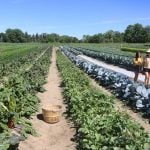By Rod Nickel and Simon Doyle of Reuters
WINNIPEG/OTTAWA, Dec 4 – Canada produced more wheat and canola than expected, as dry weather gave way to crucial rains later in summer, Statistics Canada said on Friday in its final 2015 crop report.
After the report, traders drove down ICE Canada January canola futures one percent. The market had expected Statistics Canada to raise its estimate, but the government agency’s figure easily topped even the highest trade guess in an earlier poll.
Read Also

Mixed year for hail claims across Prairies: CCHA
The 2025 crop year was an average year for hail across the Canadian Prairies, with overall claim numbers down slightly compared to last year, reported the Canadian Crop Hail Association (CCHA).
Statscan, using a farmer survey, estimated canola production at 17.2 million tonnes, sharply higher than Statscan’s previous estimate for 14.3 million and the average trade guess of 15.6 million tonnes.
The harvest was five percent larger than last year’s output and the second-biggest ever.
“The canola number is a shock,” said Lawrence Klusa, senior market coach with AgriTrend, adding that it also points to larger supplies at July 31, the end of the crop marketing year.
The average canola yield jumped eight percent year over year to 38 bushels per acre, the second highest on record, despite dry conditions in Saskatchewan and Alberta that by late July had produced noticeably shorter than usual plants.
Canada is one of the world’s largest wheat exporters and the biggest shipper of canola.
Statscan pegged the all-wheat crop at 27.6 million tonnes, exceeding its October estimate of 26.1 million tonnes and the average trade expectation of 26.7 million tonnes. Production dipped six percent from last year.
The average total wheat yield, which factors in spring, winter and durum wheat, dipped seven percent to 42.8 bushels per acre.
Minneapolis March spring wheat futures shrugged off the report, and rose 0.7 percent in early trading.
Statscan’s estimates initially look bearish for canola and wheat, but steady demand for both crops and smaller leftover supplies from the previous harvest partly offset the extra output, said Bruce Burnett, weather and crop specialist at grain handler G3 Canada Limited.
Barley, oats and durum crops were all bigger year over year. The barley harvest climbed 15.5 percent to 8.2 million tonnes, exceeding the 7.6 million expected.
Oat production was up 15 percent to 3.4 million tonnes, in line with expectations. The durum harvest of 5.4 million tonnes was up four percent year over year and surpassed the average trade estimate of 5.1 million tonnes.
The text of the Statistics Canada commentary is below the chart.
| 2014 | Sept 2015 | Nov 2015 | 2014 to 2015 % | |
| Total wheat | 29.420 | 26.061 | 27.594 | -6.2 |
| – Durum | 5.193 | 4.744 | 5.389 | +3.8 |
| – Spring | 21.298 | 19.054 | 19.962 | -6.3 |
| – Winter | 2.929 | 2.263 | 2.243 | -23.4 |
| Barley | 7.119 | 7.610 | 8.226 | +15.5 |
| Canary seed | 0.125 | 0.118 | 0.149 | +19 |
| Canola | 16.410 | 14.297 | 17.231 | +5 |
| Chickpeas | 0.131 | 0.105 | 0.084 | -32.1 |
| Corn | 11.487 | 12.204 | 13.559 | +18 |
| Dry beans | 0.273 | 0.245 | 0.243 | -10.9 |
| Dry peas | 3.810 | 3.156 | 3.201 | -16 |
| Fall rye | 0.218 | 0.234 | 0.226 | +3.7 |
| Flax | 0.873 | 0.889 | 0.942 | +8 |
| Lentils | 1.987 | 2.162 | 2.373 | +19.4 |
| Mustard | 0.198 | 0.109 | 0.123 | -37.7 |
| Oats | 2.979 | 3.292 | 3.428 | +15.1 |
| Soybeans | 6.049 | 5.928 | 6.235 | +3.1 |
| Sunflower | 0.055 | 0.091 | 0.073 | +32 |
Statistics Canada comments:
Nationally, production of most major field crops increased in 2015, while wheat and dry peas production declined. Soybean production reached a record high for the seventh consecutive year.
Soil conditions in Alberta and Saskatchewan improved towards harvest as early dry weather gave way to mid-to-late summer rains. Consequently, yield expectations improved through the latter parts of the growing season. Eastern Canada as well as Manitoba saw more temperate and consistent growing conditions, which contributed to robust production for several crops.
Wheat
Total wheat production declined 6.2% to 27.6 million tonnes in 2015. While harvested area edged up from 2014 to 23.7 million acres, average total wheat yield declined 3.3 bushels per acre from a year earlier to 42.8 bushels per acre in 2015. Dry conditions during the growing phase in much of Canada’s wheat belt contributed to lower crop yields. In comparison, the United States Department of Agriculture estimates for its 2015 crop year show an all-wheat yield of 43.6 bushels per acre, essentially unchanged from a year earlier.
Despite similar harvested areas compared with 2014, total wheat production fell in Saskatchewan and Alberta, as average yields declined in both provinces.
In Saskatchewan, wheat production declined 7.9% to 13.0 million tonnes as average yield fell 8.1%, from 40.5 bushels per acre in 2014 to 37.2 bushels per acre in 2015.
In Alberta, wheat production decreased 11.3% to 8.3 million tonnes, with the average yield falling 5.5 bushels per acre to 46.2 bushels per acre.
In contrast, wheat production in Manitoba rose 11.1% to 4.2 million tonnes, as harvested area increased 9.8% to 3.1 million acres, while average yield edged up to 50.3 bushels per acre.
Canola
Canola production rose 5.0% to 17.2 million tonnes in 2015, the result of an increase in average yield from 35.1 bushels per acre in 2014 to 38.0 bushels per acre in 2015. This marked the second highest canola yield on record, following the 40.6 bushels per acre posted during the bumper crop of 2013.
In Saskatchewan, canola production rose 10.4% to 8.8 million tonnes as average yield rose 10.6%, from 33.0 bushels per acre in 2014 to 36.5 bushels per acre in 2015. Harvested area was essentially unchanged from a year earlier.
Manitoba farmers reported canola production of 2.9 million tonnes, up 13.8% from the previous year. An 11.9% increase in the average yield from 36.0 bushels per acre to 40.3 bushels per acre was the main contributor to the gain.
In contrast, canola production in Alberta fell 6.1% to 5.4 million tonnes. Harvested area was down 10.0%, while average yield rose from 38.0 bushels per acre in 2014 to 39.7 bushels per acre in 2015.
Corn for grain
Production of corn for grain rose 18.0% from 2014 to 13.6 million tonnes in 2015. This was the result of a 10.4% increase in average yield to 164.7 bushels per acre, coupled with a 210,200 acre rise in harvested area to 3.2 million acres.
Ontario is the leading producer of corn for grain in Canada, accounting for an average of two-thirds of total production over the past five years. In 2015, Ontario’s production of corn for grain rose 16.3% to 8.8 million tonnes. This gain was attributable to a 9.7% increase in harvested area, combined with an increase in average yield from 160.9 bushels per acre in 2014 to 170.6 bushels per acre this year. Genetically modified corn for grain accounted for 81.3% of Ontario’s 2015 production of this crop.
Corn for grain production in Quebec rose 24.2% to 3.8 million tonnes, led by a 20.5% increase in average yield to 164.6 bushels per acre as well as a 3.1% gain in harvested area to 899,500 acres. Genetically modified corn for grain accounted for 85.4% of Quebec’s total corn for grain production in 2015.
In Manitoba, corn for grain production rose 13.1% to 787 400 tonnes, as a result of an increase in average yield from 111.8 bushels per acre to 126.5 bushels per acre.
Soybeans
Canadian farmers reported a seventh consecutive record of soybean production in 2015, up 3.1% from 2014 to 6.2 million tonnes. While harvested area fell 2.2%, average yield rose from 40.2 bushels per acre in 2014 to 42.4 bushels per acre in 2015. The overall increase was attributable to record production levels in Manitoba and Quebec, as production in Ontario declined.
Soybean production in Manitoba reached a fourth consecutive record high, up 25.5% from 2014 to 1.4 million tonnes in 2015. This was the result of an increase in average yield from 32.3 bushels per acre to 37.0 bushels per acre and a 9.5% increase in harvested area.
Quebec also reported a fourth consecutive record high, with soybean production rising 11.4% to 1.0 million tonnes. This gain was the result of a 22.2% increase in average yield to 47.3 bushels per acre as harvested area fell 8.8% from the previous year. The production of genetically modified soybeans accounted for 58.4% of total soybean production in Quebec in 2015.
In Ontario, soybean production fell 5.2% from 2014 to 3.6 million tonnes, in line with a decline in harvested area. Average yield was steady at 45.5 bushels per acre. Genetically modified soybean production in the province reached 2.3 million tonnes in 2015, accounting for 62.9% of total soybean production in Ontario.
Barley and oats
Farmers reported a 15.5% increase in barley production to 8.2 million tonnes in 2015. This was the result of increases in both harvested area, up 10.2% to 5.8 million acres, and average yield, up 5.0% to 65.0 bushels per acre. The increase in production in 2015 returned barley to the five-year average (2010 to 2014), but was well below the record set in 1996 of 15.6 million tonnes.
Oat production increased 15.1% from 2014 to 3.4 million tonnes nationally in 2015. This gain was the result of a 13.7% increase in harvested area to 2.6 million acres and a 1.3% advance in average yield to 85.3 bushels per acre. Oat production in 2015 surpassed the recent 5-year average, but matched the 10-year average (2005 to 2014). The highest level of oat production occurred in 1942, when 9.9 million tonnes were produced.














